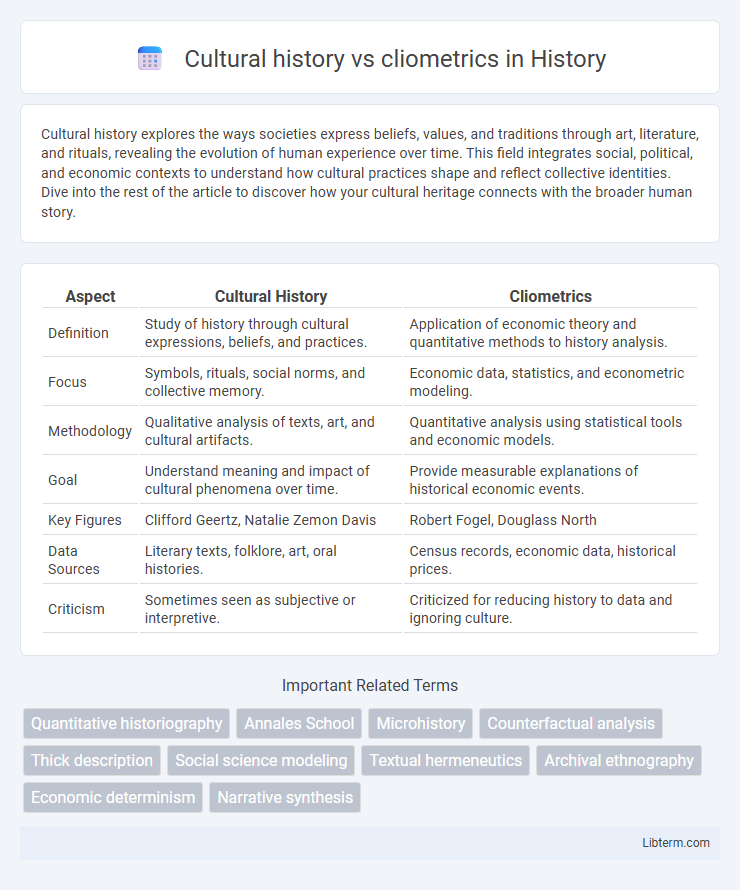Cultural history explores the ways societies express beliefs, values, and traditions through art, literature, and rituals, revealing the evolution of human experience over time. This field integrates social, political, and economic contexts to understand how cultural practices shape and reflect collective identities. Dive into the rest of the article to discover how your cultural heritage connects with the broader human story.
Table of Comparison
| Aspect | Cultural History | Cliometrics |
|---|---|---|
| Definition | Study of history through cultural expressions, beliefs, and practices. | Application of economic theory and quantitative methods to history analysis. |
| Focus | Symbols, rituals, social norms, and collective memory. | Economic data, statistics, and econometric modeling. |
| Methodology | Qualitative analysis of texts, art, and cultural artifacts. | Quantitative analysis using statistical tools and economic models. |
| Goal | Understand meaning and impact of cultural phenomena over time. | Provide measurable explanations of historical economic events. |
| Key Figures | Clifford Geertz, Natalie Zemon Davis | Robert Fogel, Douglass North |
| Data Sources | Literary texts, folklore, art, oral histories. | Census records, economic data, historical prices. |
| Criticism | Sometimes seen as subjective or interpretive. | Criticized for reducing history to data and ignoring culture. |
Introduction to Cultural History and Cliometrics
Cultural history emphasizes qualitative analysis of human experiences, values, and symbols to understand historical contexts, focusing on narratives, beliefs, and social practices. Cliometrics applies quantitative methods, using statistical data and economic models to analyze historical events and trends systematically. These approaches contrast in methodology but complement each other by providing both interpretative depth and empirical rigor in historical research.
Defining Cultural History: Origins and Scope
Cultural history emerged as a distinct field in the 19th century, focusing on the study of customs, beliefs, arts, and social practices to understand societal evolution. Unlike cliometrics, which applies quantitative methods and economic theory to historical analysis, cultural history emphasizes qualitative data and interpretive narratives. Its scope includes examining symbols, rituals, and daily life to capture the lived experiences and mentalities of past cultures.
The Emergence of Cliometrics: Quantitative Historical Analysis
Cliometrics emerged in the mid-20th century as a revolutionary approach that uses quantitative methods and economic theory to analyze historical data, contrasting with traditional cultural history's emphasis on narrative and qualitative interpretation. Pioneered by economists like Douglass North and Robert Fogel, cliometrics applies statistical techniques and mathematical models to uncover patterns and test hypotheses about economic and social history. This method transformed historical scholarship by providing empirical evidence and fostering interdisciplinary collaboration between economics, history, and statistics.
Methodological Differences: Qualitative vs Quantitative Approaches
Cultural history emphasizes qualitative methods, analyzing narratives, symbols, and cultural contexts to interpret historical experiences and meanings. Cliometrics relies on quantitative techniques, employing econometric models and statistical data to measure historical phenomena and test hypotheses. These methodological differences highlight cultural history's focus on subjective interpretation versus cliometrics' priority on empirical measurement and data-driven analysis.
Key Debates between Cultural Historians and Cliometricians
Key debates between cultural historians and cliometricians center on methodology and interpretative approaches; cultural historians emphasize qualitative analysis of narratives, symbols, and human experiences, while cliometricians prioritize quantitative data and statistical methods to uncover economic patterns. Disagreements arise over the validity of using econometric models to understand complex social phenomena, with cultural historians arguing that such models often overlook cultural context and subjective meanings. The tension reflects broader disciplinary divides between interpretive depth and empirical rigor in historical scholarship.
Case Studies: Cultural Interpretation versus Data-Driven Insights
Case studies in cultural history emphasize rich, qualitative interpretations of historical events through narratives, symbols, and social context, offering deep insights into human behavior and cultural meaning. Cliometrics applies quantitative methods and econometric models to historical data, revealing patterns and trends that may challenge traditional cultural interpretations. The interplay between cultural history and cliometrics highlights the contrast between subjective cultural analysis and objective data-driven insights in understanding the past.
Impact on Historical Scholarship and Narratives
Cultural history enriches historical scholarship by emphasizing the importance of symbols, beliefs, and everyday experiences, offering nuanced narratives that highlight diverse perspectives and social practices. Cliometrics applies quantitative methods and economic theory to history, transforming historical narratives through data-driven analysis and providing empirical insights into economic and social patterns. The impact of these approaches shapes the field by balancing interpretive depth with statistical rigor, expanding the scope and precision of historical understanding.
Limitations and Criticisms of Both Approaches
Cultural history faces limitations due to its subjective interpretations and reliance on qualitative sources, which can lead to bias and lack of empirical rigor. Cliometrics, while emphasizing quantitative methods and statistical analysis, is often criticized for oversimplifying complex cultural phenomena and ignoring the nuanced context behind historical data. Both approaches struggle to fully capture the multidimensional nature of history, highlighting the need for interdisciplinary methodologies to address their respective weaknesses.
The Future of History: Integrating Cultural and Cliometric Methods
The future of history hinges on integrating cultural history's qualitative insights with cliometrics' quantitative rigor to deepen understanding of historical phenomena. By combining narrative-driven analysis of cultural contexts with econometric models and statistical data, historians can uncover complex patterns in societal change and human behavior. This interdisciplinary approach enhances both the richness and empirical validity of historical research, fostering more comprehensive interpretations of the past.
Conclusion: Toward a Holistic Understanding of the Past
Cultural history emphasizes the interpretive analysis of symbols, narratives, and human experiences to understand the past, while cliometrics applies economic models and quantitative methods to uncover patterns in historical data. Integrating both approaches offers a comprehensive framework that captures the richness of cultural context alongside empirical rigor. This holistic understanding facilitates more nuanced insights into historical phenomena, bridging subjective meanings with objective measurements.
Cultural history Infographic

 libterm.com
libterm.com